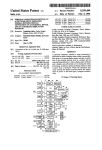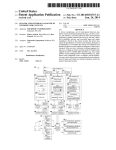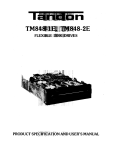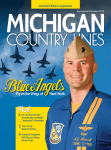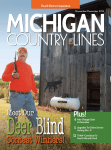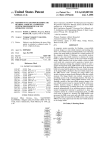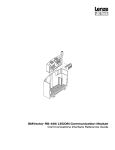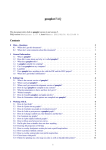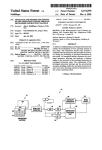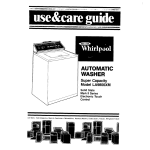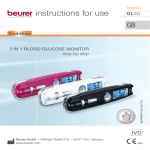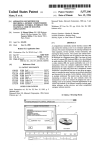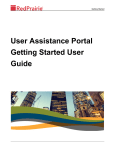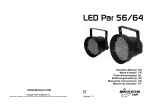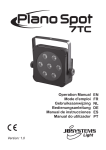Download Multi-programmed data processing system with facility for inspecting
Transcript
United States Patent 1191“ [11] [45] Cliff et al. [54] MULTI-PROGRAMMED DATA [75] Inventors: John F. Cliff, Bracknell; Robert R. Walton, Woking, both of England [73] Assignee: International Computers Limited, London, England [21] Appl. No.: 789,323 [30] Oct. 21, 1985 Foreign Application Priority Data Nov. 10, 1984 [GB] United Kingdom .... .. 8428443 [51] 1111. cu .............................................. .. G06F 3/14 [52] US. Cl. .................................. .. 340/723; 364/900; 340/724; 340/721; 340/712 [58] Field of Search 364/200 MS File, 900 MS File; 340/707, 709, 712, 714,798, 799, 723, 721, 724, 747 [56] 4,200,869 4,484,302 Cason et al. . . . . ... .. 340/723 . . . .. 4,550,386 11/1985 Hirosawa et a]. .. 4,556,954 4,586,035 4,611,306 4,641,262 4,670,752 Advani et al. Baker et a1. Crehan et al. Bryan et a1. Marcoux .......................... ..'. 12/1985 4/1986 9/1986 2/1987 6/1987 [57] ABSTRACT A data processing system that can execute a plurality of programs concurrently and has a display screen for displaying data associated with any one of the pro grams. Each program maintains display screen data indicating the current status of the program. The system maintains a REVIEW menu containing a list of the programs that have display screen data available. When a REVIEW key is pressed, the REVIEW menu is dis played. By pressing a further key, one of the listed pro grams can then be selected, and its display screen data is displayed on the screen. When the key is released, the SUME menu lists programs that are currently in a back Mercurio et al. ................. .. 364/200 4/1980 Murayarna et a1. 11/1984 87-90, 99-108. Primary Examiner-Gary V. Harkcom Assistant Examiner-Randy W. Lacasse Attorney, Agent, or Firm—Lee, Smith & Zickert of the REVIEW key is restored to the screen. A RE U.S. PATENT DOCUMENTS 3/1978 Dec. 15, 1987 information that was being displayed prior to operation References Cited 4,079,449 4,713,656 OTHER PUBLICATIONS Macintosh User's Manual, 1983, pp. 13-41, 54-75, PROCESSING SYSTEM WITH FACILITY FOR INSPECI‘ING STATE OF BACKGROUND PROGRAM [22] Filed: Patent Number: Date of Patent: 364/900 .... .. 364/900 364/900 340/712 364/900 364/900 340/721 ground mode, and can be called up by pressing a RE SUME key, allowing one of those programs to be put into a foreground mode in which it has access to the screen. Another menu lists programs that are available for execution and can be called up by pressing a START key, allowing one to be selected for execution. 6 Claims, 5 Drawing Figures US. Patent Dec. 15, 1987 Sheet 1 of 5 /21 MAGNET/C TAPE DRIVE / 15 BATTERY 12 14 / l R0” /3 /17 DYNAMIC RAM OUTPUT L'UNTRULLER /10 sTAT/c RAM 1 /22 18\ INPUT PRINTER -— ROM MODULE 11 pRocEssaR 4,713,656 ~76 I 19 20 BATTERY TELEPH/ONE —J \27 ($755235? 8CONTROLLER KEYBUARD 23 wsuAL ?lljvljl-TAY t 26 /24 KEYBOARD TELEPHONE “N55 /25 TELEPHONE HANDSET Haj US. Patent Dec. 15,1987 Sheet 2 0f 5 4,713,656 FOREGROUND MODE TERM/NA TED SUSPEND FROM FOREGROUND 32 \ \ START \ BAL'KEROUND _______ MODE FIN/SHED REQUIRE USE OF 33 31 SCREEN/KEYBOARD \ WAITING FOR FOREGROUND FOREGRUUND AL LUCA TEL7 H52 ,DORMANT US. Patent Sheet 3 0f 5 Dec. 15, 1987 FIND FDREGRDUND A PPL IL'ATIDN i EXTENDED EXTENDED DR TRANSIENT .7 SUSPEND FROM TRANSIENT TERM/NA TE FDREGRDUND l I DISPLAY TOP-LEVEL MENU i KEY OPERATED START SELEC TED APRL/L'A T/DN i ALL DEA TE FOREGROUND I‘ END F703’. 4,713,656 US. Patent Dec. 15,1987 Sheet 40f5 FIND FOREGROUND APPLICATION i EXTENDED EXTENDED TRANSIENT 0/? F TRANSIENT? W SUSPEND FROM FOREGROUND Nm/E _ TERM/NATE FIND HOW MANY AWL/(Arms WAITING FOR FOREGROUND m m?gxi’? (Fig 3, ) ioNE ALLOCATE MORE THAN oNE 05pm Rlégxléf FURL-‘GROUND ggRATED 1 ALLOCATE SELECTED APPLIT%4TION FOREGROUND 56.4. 4,713,656 U.S. Patent Dec. 15, 1987 Sheet 5 0f 5 FIND FOREGROUND APPL ICA TION SUSPEND FRUM FUREGROUND i DISPLAY REVIEW MENU SINGLE RESUME KEY F______ KEY START KEY FUNCTION KEY + WAKE UP REVIEW ACTIVITY KEY RELEASED TERM/NA TE REVIEW ACTIVITY I RE-ALLOCATE FOREGROUND F765. OTHER KEY WAKE UP REVIEW ACTIVITY RESUME KEY 4,713,656 1 4,713,656 MULTI-PROGRAMMED DATA PROCESSING SYSTEM WITH FACILITY FOR INSPECI'ING STATE OF BACKGROUND PROGRAM BACKGROUND TO THE INVENTION This invention relates to data processing systems. The invention is particularly, although not exclusively, con cerned with data processing systems of the kind usually referred to as personal computers. Such computers are normally used by non-computer-oriented persons, or inexperienced users. It is therefore desirable that they should provide functions which are natural in their operation and easy to use with little or no training and minimal reference to documentation. Such a system may be designed to allow a plurality of different application programs to be executed concur rently. For example, it is possible to run a word process ing program while at the same time running a program which is accessing a remote database. Normally, a per sonal computer is provided with just a single screen, to keep the cost to a minimum. In order to view the states of the different applications programs, it has been pro posed to use a “windowing” technique, in which the 2 ci?cally released e.g. by means of a further key opera tion. The use of menus to guide the inexperienced user is known in itself. However, in conventional systems, the menu called up by the user is generally a high-level menu, showing all the available programs of the system. It is therefore usually necessary to display further, sub sidiary menus, listing the options in more detail, before the user can make the ?nal choice. In contrast, in the present system the menu which is displayed as a result of pressing the REVIEW key is one specially con structed for this purpose, and contains only those pro grams which currently have displays available for view mg. In a personal computer, it is desirable for the user to be able to initiate new application programs at will as the need arises, with the minimum of complication and effort. In the system described herein, this facility is provided by means of a further manually operable key (the “START key”) which, when operated, and causes the screen to display a menu indicating available appli cation programs, allowing one of those programs to be selected for execution by the system. screen is divided into a number of separate areas, each of which is allocated to a different program. Thus the user can, for example, refer to data retrieved from the Preferably, at any given time one of the programs is allocated to a foreground mode in which it is allowed to access the screen, the other programs all being allocated to a background mode in which they are not allowed to database while using the word processing program. access the screen. The system conveniently includes a However, the windowing technique is inconvenient, since it introduces extra complexity in the system and restricts the screen area available to each program. One object of the present invention is to provide a way of dealing with this problem which is more conve nient than the windowing technique and which is suit able for use by the inexperienced user. further manually operable key (the “RESUME key") which when operated, causes the current foreground program to be put into the background mode and causes the background program if any to become the new foreground program in its place or, if there is more than one background program currently waiting to use the screen, displays a menu indicating which programs are so waiting. Thus, it can be seen that the START and RESUME keys provide a convenient mechanism to allow the user SUMMARY OF THE INVENTION According to the invention, there is provided a data processing system arranged to execute a plurality of 40 to initiate new programs and to return to a previous program as required. programs concurrently and having a display screen for Preferably, the programs are divided into two cate displaying data associated with any one of the pro gories, extended and transient, and the operation of the grams, characterised in that: START or RESUME key causes the current fore (a) each of the programs maintains display screen data ground program to be automatically terminated if it is indicating the current status of that program, transient, but allows that program to continue running (b) the system maintains a review menu containing a list as a background program if it is extended. This is conve of those programs having display screen data cur nient, since it means that, in the case of a transient pro gram, the user does not have to speci?cally terminate it which, when operated, causes the review menu to be 50 when he switches to another program. displayed on the screen in place of any information BRIEF DESCRIPTION OF THE DRAWINGS rently available, (c) the system has a manually operable review key currently displayed there, and One data processing system in accordance with the invention will now be described by way of example one of the programs listed on that menu and to cause 55 with reference to the accompanying drawings. FIG. 1 is a block diagram of the system. the display screen data of the selected program to be FIG. 2 is a state diagram of a typical application displayed on the screen. program. It can be seen that the REVIEW key thus allows a FIGS. 3,4 and 5 are state diagrams of an application quick, unpremeditated inspection of the state of any handler mechanism. selected program. Preferably, when the review menu is displayed, the OVERALL VIEW OF THE SYSTEM (d) the system has manual selection means, operable when the review menu is being displayed to select user can select one of the programs listed in the menu Referring to FIG. 1, the system is based on a micro processor 10 which acts as the central processing unit. the selected program is then displayed on the screen only for as long as the user holds down that key. How 65 In the present system, the microprocessor is a Motorola MC68008, operating at a clock rate of 7.5Ml-Iz. The ever, the user preferably also has the option of pressing microprocessor 10 is connected to a bus 11 which a different key or combination of keys to cause the carries data, addresses and control signals. selected display to be held on the screen, until it is spe by pressing a single key, and the display screen data of 3 4,713,656 The bus 11 is connected to a 128K byte ROM 12, a 128K byte dynamic RAM 13, and a 2K byte static RAM 14. The static RAM is provided with a back-up battery 15 so that data in it is preserved when the system is powered down. The bus 11 is also connected to a socket 16 for receiving a plug-in ROM module 17. This can be used to supply optional software packages as required. The bus 11 is also connected to an input/output con troller 18, a display controller 19, and a telephone and keyboard controller 20. The input/output controller 18 controls a pair of magnetic tape drive units 21 (only one shown) of the kind using endless loop magnetic tape 4 present, and decides which activity should be selected next. Each activity has a 32-bit event register held in its allocated area of RAM. Any activity can request the kernel to set one of the bits in the event register of another activity. When an activity runs, it can test the bits of its event register, and can take different actions according to their settings; for example, it can decide to wait until a bit has been set before taking a particular action. This provides a means for communication be tween activities. Control programs for multi-tasking systems are well known in the art and so it is not necessary to describe cartridges as removable storage media. The unit 18 also the kernel in any greater detail. controls a printer 22. The display controller 19 is con 15 Application programs nected to a visual display unit 23, having a CRT screen for viewing by the system user. The telephone and The user of the system will require to run one or keyboard controller 20 supervises a keyboard 24, tele more application programs. These may either be sup phone handset 25 and two telephone lines 26. plied with the system, or written by the user, or pur The keyboard contains all the usual keys, arranged in 20 chased from a third party. Application programs may the conventional QWERTY layout, and also includes include, for example, programs for word processing, special system keys, labelled START, RESUME and spread sheet analysis, data base management, and mes REVIEW, the function of which will be described in sage handling. These application programs can be pro detail later. The keyboard also includes a numeric key vided as standard items in the ROM 12, or can be sup pad of the type used in push-button telephones. The 25 plied as options in the form of ROM modules 17. Alter controller 20 uses this keypad, in conjunction with the handset 25 and telephone lines 26, to allow the user to make and receive telephone calls in the conventional natively, they can be supplied on magnetic tape car tridges, and loaded into the RAM 13 from the tape drive unit 21 when required. manner. It also allows the system to transmit and re 30 Each application program is treated by the system as ceive data over the lines 26. The controller 20 continuously monitors the key board 24 and whenever it detects a change of state of one or more activities, which are scheduled by the kernel as described above. Hence, several application programs can be active concurrently in the system. any of the keys, it produces an interrupt signal to the In general, application programs require to interact processor 10. The controller 20 has a back-up battery 35 with the system user by means of the display screen 23 27, which allows the voice telephony function to con and keyboard 24. However, only one of the currently tinue even when the system is powered down. active applications is allowed to use the screen and Multi-tasking keyboard at any given time. This is referred to as the to as "activities”) can be executed concurrently. Actu ally, the processor 10 can only execute one activity at a background mode. An application in background mode foreground application and is said to be running in fore The system is designed to allow multi-tasking: i.e. a 40 ground mode. Any other currently active applications number of different tasks or processes (herein referred are referred to as background applications, running in time, and multi-tasking is achieved by rapidly switching can continue to perform processing which does not require the use of the screen and keyboard: for example, between the different activities so as to give the impres 45 it can continue to send and receive data over one of the telephone lines. However, if it reaches a stage where it sion that they are all being executed simultaneously. Scheduling and co-ordination of the activities is car ried out by an item of system software referred to as the kernel, which runs on the processor 10. The kernel also requires to interact with the user before it can proceed provides low-level management of the various parts of any further, it makes a request to use the screen and keyboard, and then goes into a waiting state. The system user can choose which of the applications the system, including handling of interrupts from the controllers 18,19,20. is to be in the foreground mode, by use of the START and RESUME keys, as will be described later. Each activity has its own stack and register values Applications are classified as extended or transient. which are held in an area of the RAM 13 allocated to Transient applications are typi?ed by relatively short that activity. When the kernel selects an activity to run, 55 access to the screen and keyboard to perform single updates or enquiries on data held in the system, and they are likely to be invoked at unpredictable times while it loads the register values of that activity into the actual registers of the processor 10, and then passes control of the processor to that activity. The activity then runs until either: (a) it completes its processing task, longer applications are running. An example of a tran sient application is one which provides a telephone 60 directory service, where the user may wish to access (b) it reaches a point where it must wait for a response from some other part of the system, or the directory from time to time to look up a telephone (c) an interrupt signal is received. new foreground application by operation of the The interrupt may be from one of the controllers 18, number or to update an entry. When the user selects a START or RESUME keys, the assumption is that he 19,20, requesting some service, or may be a time-out 65 has ?nished with the transient application and so it is interrupt, indicating that the current activity has used terminated. This is a very convenient feature, since it up its time allocation. When any of these events occurs, allows the user to terminate such applications without the kernel takes over again, examines any interrupts the need for an explicit command. 5 4,713,656 Extended applications are typi?ed by lengthy user interactions by way of the screen and keyboard. The user may wish to break off to perform other, more urgent, tasks while retaining the ability to return to the 6 (b) its address, in ROM or RAM. (c) an activity identi?er, which is used by the kernel to identify the activity. (d) status ?ags indicating the status of the application. extended application. Thus, when the user selects a new These include flags to indicate whether or not the foreground application by means of the START and RESUME keys, the extended application is not termi nated but is simply put into the background mode, relin quishing the screen and keyboard until it is selected again as the foreground application. In the meantime, it can continue processing if appropriate. Some applications may be wholly transient or wholly application has requested to be put into the fore ground mode, whether the foreground has been allov extended. However, some applications may be some times transient and sometimes extended. For example, a teletext program may be extended when handling con nections to a teletext computer over the telephone line, but transient when displaying stored pages captured during a previous connection. cated to it, and whether this is an extended or tran sient application. When the system is initially powered up, the applica tion handler puts a number of ?xed entries into the program table, corresponding to those applications which are supplied as standard features of the system. The application handler then scans all addresses at which an application program might exist, whether in the ROM 12 or the plug-in ROM modules 17. When ever it ?nds an application program at any of these addresses, it makes a corresponding entry into the pro gram table. When requested by the user, it also reads the application program. State 30 represents the foreground 20 names of any application programs supplied on mag netic cartridge in the tape drive 21, and makes tempo mode, in which the application is active and has access rary entries in the program table for them. to the screen and keyboard. If the application is tenni Referring to FIG. 2, this is a state diagram of a typical nated, it immediately stops using the screen and key board. It may, however, continue running to complete The program table is updated by the application han dler whenever it makes a scheduling decision (e. g. allo any data transfers it may have been performing, so as to 25 cating the foreground mode to an application), and by the applications when they make a call to the applica leave the data in a consistent state. It then goes into the tion handler to notify it of a change of state (e.g. re dormant state 31. The application will remain in this questing to be put into the foreground mode). state until it is restarted (by use of the START key). It FIGS. 3,4 and 5 show a state diagram of those parts will then request to be allowed to use the screen and of the application handler relevant to the present inven keyboard, and when this request is granted, goes into tion. the foreground mode. If the application is suspended from the foreground START key mode (by use of the START or RESUME key) it imme Referring to FIG. 3, when the START key is diately stops using the screen and keyboard. If it is an extended application, it then enters the background 35 pressed, this is detected by the keyboard controller 20, which causes an interrupt in the processor 10. This is mode (state 32), in which it continues to run, without detected by the kernel, which informs the application using the screen or keyboard. (In the case of a transient handler by setting one of the bits in its event register. application, suspension from the foreground mode The application handler then consults the program causes the application to go into the dormant state). table to find which application is currently in the fore If the application completes its processing in the ground mode, and whether it is extended or transient. If background mode, it terminates and goes into the dor it is an extended application, the application handler mant state 31. However, if it reaches a stage where it requires to use the screen or keyboard, it goes into a suspended state 33, waiting for the use of the screen and keyboard to be allocated to it. When they are allocated, the application returns to the foreground mode 30. Application handler The applications programs are supervised by a mech anism referred to as the application handler. The appli cation handler may be a systems program, which runs on the processor 10 and is treated as an activity by the kernel, being multi-tasked with the other activities. Alternatively, the application handler could be imple sends it a message, instructing it to stop using the screen and keyboard. Alternatively, if the application is tran sient, the application handler sends it a message instruct ing it to terminate. In either case, the application handler receives from the application an acknowledgement that it has stopped using the screen and keyboard. The application handler then uses the screen to display a top-level menu, listing all the applications that are currently available for run ning on the system. It then waits for another key to be pressed. The user may select any of the applications listed in 55 the top-level menu, by pressing the key indicated by the mented wholly or partly by means of hardware. menu. (For example, a calculator program may be se The application handler acts as a high-level sched lected by pressing the “6” key). This is detected by the uler, allowing the user to decide which applications are kernel and noti?ed to the application handler. The ap to be run and which of these is to be the foreground plication handler then requests the kernel to start up the application, with access to the screen and keyboard. The user interacts with the application handler by selected application. As soon as the selected application starts running, it means of the START, RESUME and REVIEW keys, sends a message to the application handler, requesting as described below. permission to go into the foreground mode, and also The application handler makes use of a table, referred informing the application handler whether it is cur to as the program table, which is held at a predeter mined location in the RAM 13. This contains an entry 65 rently extended or transient. The application handler updates the program table, and sends a message back to for each application program currently known to the the application, telling it that it has been allocated to the system. Each entry contains: foreground mode. (a) the name of the application. 7 4,713,656 Alternatively, when the top-level menu is displayed, 8 application to terminate. The application handler then the user may press a key which selects a subsidiary causes a special REVIEW menu to be displayed. This menu, listing further applications. This will lead the application handler into further states (not shown) which display the subsidiary menu and start the selected lists all the applications which currently have review screens available for inspection. The user can select one of these screens in two ways. application. The first way is to press and hold down a single key, corresponding to the desired review screen as indicated on the review menu. For example, the review screen for RESUME key Referring now to FIG. 4, when the RESUME key is the spread sheet program may be selected by pressing pressed, the application handler again consults the pro the “3" key. This causes the application handler to send gram table to find which application is currently in the foreground mode, and whether it is extended or tran a “wakeup” message to a special activity referred to as the review activity. This activity then runs, and causes the review screen of the selected application to be dis played on the screen of the display unit. sient. If the foreground application is extended, it is suspended from foreground mode. If, on the other hand, it is transient, it is terminated. In either case, the next 5 Meanwhile, the application handler checks, every action of the application handler is to consult the pro tenth of a second, whether the key has been released. gram table to determine how many applications are When the user releases the key, the application handler waiting to go into the foreground mode. sends a “terminate” message to the review activity, If no application is waiting, the application handler causing it to go back into the dormant state. Finally, the causes the top-level menu to be displayed (FIG. 3), application handler puts the application which was inviting the user to select a new application. If there is interrupted by the REVIEW sequence back into the just one application waiting, that application is put into foreground mode. the foreground mode. Finally, if there is more than one In summary, it an be seen that the review screen is displayed for as long as the user holds down the se application waiting, the application handler constructs a special resume menu, which lists all the applications waiting to be allocated to the foreground mode. This 25 lected key. As soon as the key is released, the original application is returned to the screen. The other way of selecting a review screen from the menu is displayed, allowing the user to choose one of those applications by pressing an appropriate key. The selected application is then put into the foreground review menu is to press the “Function” key on the keyboard (this is a standard key on conventional key boards) along with the numeric key on the keypad cor responding to the desired selection. For example, to select the spread sheet program in this way, the function key is pressed along with key “3" on the keypad. In this mode. It can be seen that the START and RESUME keys provide an efficient and convenient mechanism for the user to select new applications to be run, and to switch them between the foreground and background modes. case, there is no need to hold down the keyswthey can For example, if the user is running one program, and 35 be released immediately. The review activity continues wishes to break off to perform another, more urgent to run, and hence the review screen continues to be task, it is only necessary to press the START key and displayed even when the keys are released. This allows then to make the appropriate selection from the top the user to inspect the review screen at leisure, and to level menu which is displayed. When the user wishes to perform other actions such as using the telephone facil return to the original application program, it is only ity. When the user wishes to return to the original appli necessary to press the RESUME key, and the applica cation, he presses the RESUME key, which causes the tion will be restored to the foreground mode. If there is application handler to terminate the review activity. The application which was interrupted by the RE more than one application to which the user can return, he is presented with a menu from which to choose. REVIEW key The REVIEW key provides a mechanism which 45 VIEW sequence is then restored to the foreground. Alternatively, the user can press the START key, which causes the top-level menu to be displayed (FIG. 3). allows the user to make an unpremeditated inspection of Similarly, while the review menu is being displayed, data associated with an application. The REVIEW the user can press the RESUME key, which causes the action has no permanent effect on the application which 50 original application to be restored immediately, without is reviewed, nor on any other application. viewing any review screen. Alternatively, he can press Each reviewable application contains a section of the START key, to cause the top—level menu to be code which maintains a set of data referred to as the displayed. review screen, which is available for inspection during the REVIEW action. The choice of what data to in clude in the review screen is determined by the designer of the application: typically, it will be the current screen of the application, i.e. the one which would be dis The use of the START key during the REVIEW operation, as described in the preceding two para graphs, has the same effect on the interrupted applica tion as at other times i.e. the application becomes sus pended or is terminated, depending on whether it is played if the application were in the foreground mode. extended or transient. It might instead be a status report on the job being 60 handled by the application. The current foreground application may itself have a review screen which can be displayed by use of the Referring to FIG. 5, when the REVIEW key is REVIEW key, and which may contain different infor pressed, the application handler consults the program mation from that currently displayed by the application. table to find which application is currently in the fore The REVIEW mechanism may also allow inspection ground mode. It then suspends that application from the 65 of review screens containing data from applications foreground so that it stops using the keyboard and which are not currently active i.e. which are dormant. screen. This applies to both extended and transient ap For example, a telephone directory application may plications: the REVIEW key does not cause a transient remember the most recently selected entry, and the 9 4,713,656 10 REVIEW mechanism may allow this to be viewed even display screen data of the selected program to be dis when the telephone directory application is dormant. played on the screen and to be maintained on the screen For this purpose, when constructing the review menu, after that key or combination of keys has been released. 4. A system according to claim 1 including: the application handler considers not only those appli (a) means for maintaining a resume menu containing a cations which are active, but also those that are not active but may have associated stored data which is reviewable. This is achieved by an additional table list of programs currently in the background mode, (b) a manually operable resume key, (c) means responsive to operation of the resume key for causing the program currently in the fore ground mode to be reallocated to the background maintained by the application handler, in which appli cations can declare the existence of such data. What is claimed is: 1. A data processing system comprising: mode and causing the resume menu to be displayed (a) means for executing a plurality of programs con on the screen, and currently, (d) means responsive to operation of the manually (b) a display screen for displaying data associated 15 with any one of the programs, (c) means for allocating any one of the programs to a foreground mode in which it is allowed to access the display screen and for allocating the other pro operable selection means while the resume menu is being displayed, to select one of the programs listed on that menu and to allocate the selected program to the foreground mode. 5. A system according to claim 1 including: (a) means for maintaining a start menu containing a grams to a background mode in which they are not allowed to access the display screen, list of programs not currently being executed but available for execution, (d) means for maintaining, in respect of each of the programs currently in the background mode, dis (b) a manually operable start key, play screen data indicating the current status of that program, (e) means for maintaining a review menu containing a 25 (c) means responsive to operation of the start key for causing the start menu to be displayed on the screen in place of any information currently dis played there, and list of those programs currently having display (d) means responsive to operation of the manually screen data available, (f) a manually operable review key, operable selection means while the start menu is (g) means responsive to operation of the review key being displayed for selecting one of the programs to cause said review menu to be displayed on the listed on the start menu and causing that program to be executed. screen in place of information from the program 6. A method of operating a data processing system currently in the foreground mode, (h) manually operable selection means, (i) means responsive to operation of said selection comprising processing means, a display screen and a keyboard, the method comprising the steps: means when the review menu is being displayed, to 35 select one of the programs listed on that menu and to cause the display screen data of the selected program to be displayed on the screen for as long as said selection means is operated, and programs, display screen data indicating the cur rent status of the program, (c) maintaining a review menu containing a list of 0) means responsive to release of said manually oper those programs currently having display screen data available, (d) in response to operation of a predetermined key able selection means to restore to the screen the information from the program currently in the foreground mode. 2. A system according to claim 1 wherein the manu ally operable selection means comprises a plurality of (a) executing a plurality of programs concurrently in the processing means, (b) maintaining, in respect of at least some of the 45 further keys, and wherein the means responsive to oper ation of said selection means is responsive to operation of a single one of said further keys to select one of the on said keyboard, displaying the review menu on the screen, (e) in response to operation of a further key on said keyboard, while the review menu is being dis played, selecting one of the programs listed on the review menu and causing the display screen data of the selected program to be displayed on the screen, for as long as said further key is held, and programs listed on the review menu and to cause the display screen data of the selected program to be dis played on the screen for as long as that further key is held. (f) in response to release of said further key, restoring 3. A system according to claim 2 further including to the screen the information that was being dis means responsive to operation of a different one or a played prior to operation of said predetermined combination of said further keys, for selecting one of 55 key. i the programs listed on the review menu and causing the 65 t t l i












